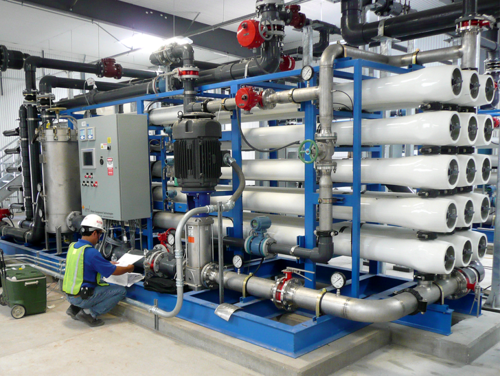Ingenious PFAS Treatment Solutions for Safer Water
The boosting prevalence of PFAS contamination in water products requires a crucial exam of ingenious treatment services. Additionally, arising bioremediation strategies provide an even more sustainable method to tackling PFAS challenges. pfas management.
Review of PFAS Contamination
PFAS contamination has actually emerged as a considerable ecological and public health and wellness problem. Per- and polyfluoroalkyl materials (PFAS) are a group of synthetic chemicals known for their perseverance in the setting and human body, leading them to be generally described as "forever chemicals." These compounds have actually been commonly used in numerous industries, including firefighting foams, water-repellent textiles, and food packaging, mainly as a result of their water- and grease-resistant homes.
The widespread usage of PFAS has led to their detection in dirt, water products, and even in the blood of human beings and animals. Research studies have actually linked PFAS direct exposure to various health concerns, consisting of developing results in infants, immune system dysfunction, and various types of cancer cells. Furthermore, the environmental persistence of these compounds complicates their destruction and elimination, elevating issues about long-term environmental effects.
Regulative bodies are progressively carrying out rigid standards to keep an eye on and lower PFAS levels in alcohol consumption water and various other environmental tools. As understanding of PFAS contamination expands, it has ended up being imperative for neighborhoods and industries to seek effective therapy options to minimize direct exposure and secure public health and wellness.
Advanced Purification Technologies
As the seriousness to attend to PFAS contamination magnifies, progressed purification modern technologies have actually emerged as a crucial part in the remediation efforts intended at getting rid of these relentless chemicals from water resources. These modern technologies take advantage of innovative mechanisms to effectively target and capture PFAS substances, which are notoriously resistant to traditional therapy approaches.
One of one of the most appealing strategies is making use of granular turned on carbon (GAC), which adsorbs PFAS molecules as a result of its high surface location and porous framework. This approach has actually been commonly implemented in both community and industrial settings, showing considerable decreases in PFAS concentrations. Additionally, ion exchange materials have actually gotten grip, specifically made to precisely bind PFAS ions from water, therefore facilitating their elimination.
Membrane layer filtering modern technologies, such as reverse osmosis and nanofiltration, additionally show efficiency in PFAS elimination by physically separating contaminants from water - pfas management. These systems can achieve high levels of purity, making them suitable for alcohol consumption water applications
Chemical Treatment Developments
Many chemical therapy technologies are being explored to efficiently deal with PFAS contamination in water products. One promising approach entails making use of advanced oxidation processes (AOPs), which utilize powerful oxidants such as ozone, hydrogen peroxide, or chlorine dioxide integrated with UV light to damage down PFAS substances right into less harmful compounds. This approach has actually demonstrated effectiveness in lab settings, revealing possible for scalability in real-world applications.
Another innovative technique is the development of ion-exchange resins specifically made to target PFAS. These resins can selectively adsorb PFAS compounds from water, permitting their elimination during therapy procedures. visit site Current developments have actually improved the effectiveness and capability of these resins, making them a desirable option for water treatment facilities.
In addition, researchers are investigating making use of chemical agents like persulfate and ferrous ions to boost the degradation of PFAS in infected water. These agents can generate chain reaction that promote the malfunction of relentless PFAS compounds.
Emerging Bioremediation Methods
Current advancements in chemical therapy technologies have actually led the way for exploring bioremediation strategies as a practical choice for addressing PFAS contamination. Bioremediation harnesses the all-natural metabolic processes of microbes to break down or transform contaminants, making it an appealing strategy for tackling consistent contaminants like PFAS.
Arising techniques in bioremediation include using genetically engineered bacteria that can especially target and damage down PFAS substances. These microbial pressures are being established for their boosted degradation abilities, raising the performance of the remediation process. Additionally, researchers are investigating the potential of plant-assisted bioremediation, where specific plant varieties may uptake and sequester PFAS from infected dirt and water.
Another promising method is the application of bioaugmentation, which involves presenting useful microorganisms into polluted environments to enhance the degradation of PFAS. This technique can help with much faster check remediation timelines and enhance total effectiveness.

Regulatory Frameworks and Standards
An extensive regulatory framework is vital for effectively taking care of PFAS contamination and guaranteeing public wellness protection. The boosting recognition of per- and polyfluoroalkyl materials (PFAS) as toxic wastes has actually motivated various government and state agencies to develop standards that control their existence in water products. The United State Environmental Security Agency (EPA) has developed health and wellness advisories and is functioning towards setting enforceable restrictions for PFAS in drinking water.
State-level guidelines vary significantly, with some states embracing more stringent guidelines than those proposed by the EPA. These policies commonly consist of optimum pollutant levels (MCLs) for details PFAS compounds, tracking demands, and reporting commitments for water utilities. In addition, arising structures focus on the remediation of infected sites, emphasizing the requirement for efficient therapy innovations.

Verdict
To conclude, the advancement and application of innovative PFAS treatment services are vital for resolving the pervasive problem of water contamination. Advanced purification innovations, chemical look these up therapies, and arising bioremediation methods jointly provide a diverse method to effectively decrease and break down PFAS levels. As regulative structures remain to develop, integrating these modern technologies will certainly be important to secure public health and restore the honesty of polluted water sources, inevitably adding to a cleaner and much safer setting.